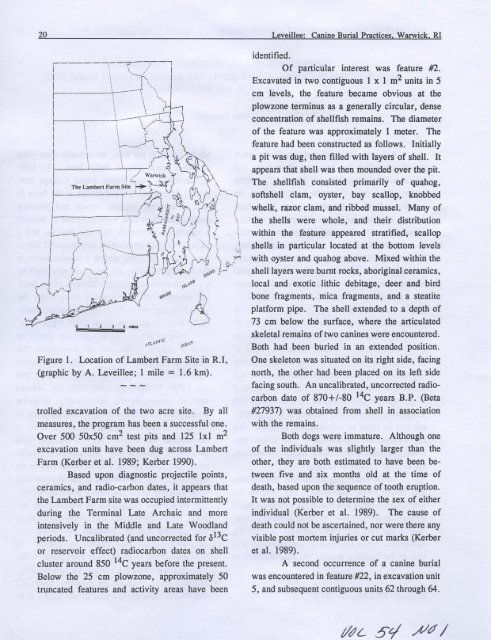Bulletin of the Massachusetts Archaeological Society, Vol. 54, No. 1 ...
Bulletin of the Massachusetts Archaeological Society, Vol. 54, No. 1 ...
Bulletin of the Massachusetts Archaeological Society, Vol. 54, No. 1 ...
Create successful ePaper yourself
Turn your PDF publications into a flip-book with our unique Google optimized e-Paper software.
20<br />
3 4 miles<br />
Figure 1. Location <strong>of</strong> Lambert Farm Site in R.I.<br />
(graphic by A. Leveillee; 1 mile = 1.6 km).<br />
trolled excavation <strong>of</strong> <strong>the</strong> two acre site. By all<br />
measures, <strong>the</strong> program has been a successful one.<br />
Over 500 50x50 cm 2 test pits and 125 lxl m 2<br />
excavation units have been dug across Lambert<br />
Farm (Kerber et al. 1989; Kerber 1990).<br />
Based upon diagnostic projectile points,<br />
ceramics, and radio-carbon dates, it appears that<br />
<strong>the</strong> Lambert Farm site was occupied intermittently<br />
during <strong>the</strong> Terminal Late Archaic and more<br />
intensively in <strong>the</strong> Middle and Late Woodland<br />
periods. Uncalibrated (and uncorrected for O l3 C<br />
or reservoir effect) radiocarbon dates on shell<br />
cluster around 850 14C years before <strong>the</strong> present.<br />
Below <strong>the</strong> 25 cm plowzone, approximately 50<br />
truncated features and activity areas have been<br />
Leveillee: Canine Burial Practices. WalWick. RI<br />
identified.<br />
Of particular interest was feature #2.<br />
Excavated in two contiguous 1 x 1 m 2 units in 5<br />
cm levels, <strong>the</strong> feature became obvious at <strong>the</strong><br />
plowzone terminus as a generally circular, dense<br />
concentration <strong>of</strong> shellfish remains. The diameter<br />
<strong>of</strong> <strong>the</strong> feature was approximately 1 meter. The<br />
feature had been constructed as follows. Initially<br />
a pit was dug, <strong>the</strong>n filled with layers <strong>of</strong> shell. It<br />
appears that shell was <strong>the</strong>n mounded over <strong>the</strong> pit.<br />
The shellfish consisted primarily <strong>of</strong> quahog,<br />
s<strong>of</strong>tshell clam, oyster, bay scallop, knobbed<br />
whelk, razor clam, and ribbed mussel. Many <strong>of</strong><br />
<strong>the</strong> shells were whole, and <strong>the</strong>ir distribution<br />
within <strong>the</strong> feature appeared stratified, scallop<br />
shells in particular located at <strong>the</strong> bottom levels<br />
with oyster and quahog above. Mixed within <strong>the</strong><br />
shell layers were burnt rocks, aboriginal ceramics.<br />
local and exotic lithic debitage, deer and bird<br />
bone fragments, mica fragments, and a steatite<br />
platform pipe. The shell extended to a depth <strong>of</strong><br />
73 cm below <strong>the</strong> surface, where <strong>the</strong> articulated<br />
skeletal remains <strong>of</strong>two canines were encountered.<br />
Both had been buried in an extended position.<br />
One skeleton was situated on its right side, facing<br />
north, <strong>the</strong> o<strong>the</strong>r had been placed on its left side<br />
facing south. An uncalibrated, uncorrected radiocarbon<br />
date <strong>of</strong> 870+/-80 14C years B.P. (Beta<br />
#27937) was obtained from shell in association<br />
with <strong>the</strong> remains.<br />
Both dogs were immature. Although one<br />
<strong>of</strong> <strong>the</strong> individuals was slightly larger than <strong>the</strong><br />
o<strong>the</strong>r, <strong>the</strong>y are both estimated to have been between<br />
five and six months old at <strong>the</strong> time <strong>of</strong><br />
death, based upon <strong>the</strong> sequence <strong>of</strong>tooth eruption.<br />
It was not possible to determine <strong>the</strong> sex <strong>of</strong> ei<strong>the</strong>r<br />
individual (Kerber et al. 1989). The cause <strong>of</strong><br />
death could not be ascertained, nor were <strong>the</strong>re any<br />
visible post mortem injuries or cut marks (Kerber<br />
et al. 1989).<br />
A second occurrence <strong>of</strong> a canine burial<br />
was encountered in feature #22, in excavation unit<br />
5, and subsequent contiguous units 62 through 64.
















